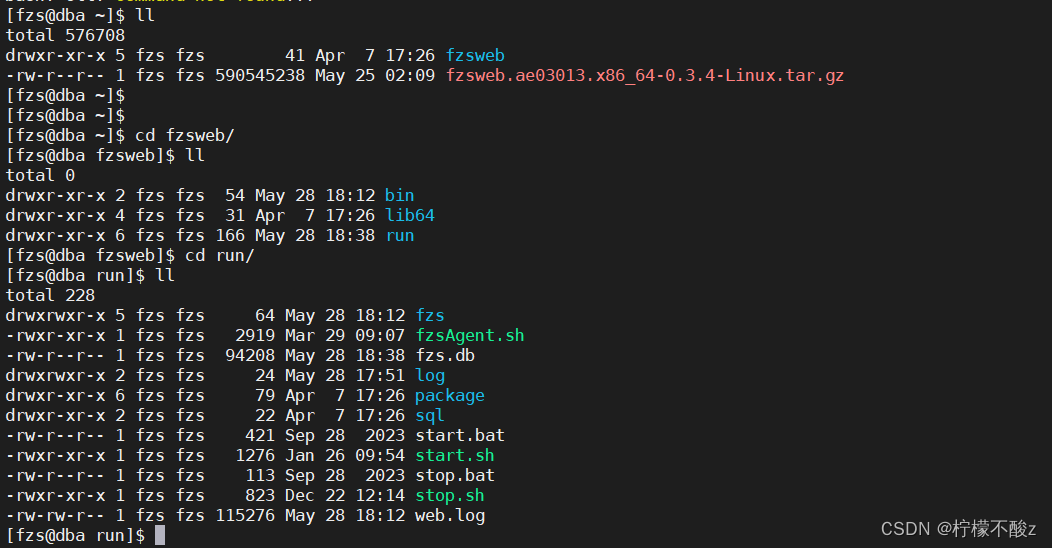1.系统架构及配置
FZS Web Server 需要部署在装有数据库的本地环境
- x86_64
- 2 CPU
- 4 GB 内存
- 20 GB 硬盘
- 数据库:oracle
2. 创建系统用户
(1)在 oracle 所在机器上创建和 oracle同组用户fzs,执行脚本自动创建用户:
#!/bin/sh
echo "please input system username to create(default:fzs):"
read sysuser
if [ ! -n "$sysuser" ]; then
sysuser=fzs
fi
SYSTEM=$(uname -s)
case $SYSTEM in
Linux | AIX)
j=3
;;
SunOS | HP-UX)
j=1
;;
*)
echo unknow system
exit 1
;;
esac
if id -u grid >/dev/null 2>&1; then
grp=$(groups grid | awk '{for(i=3;i<=NF;i++) if(i!=NF) printf $i","; else printf $i;}')
else
grp=$(groups oracle | awk '{for(i=3;i<=NF;i++) if(i!=NF) printf $i","; else printf $i;}')
fi
if [ $SYSTEM = "AIX" ]; then
UserExists=17
else
UserExists=9
fi
if [ $SYSTEM = "SunOS" ]; then
ONLY_SUN="-s /bin/bash"
fi
useradd $ONLY_SUN -G $grp -m $sysuser
if [ $? = $UserExists ]; then
echo "user $sysuser already exists,continue?(y/n) (default:n)"
read cont
case $cont in
"y")
cont=y
;;
"n")
cont=n
;;
"")
cont=n
;;
*)
echo "error parameter"
exit 1
;;
esac
if [ "$cont" = "n" ]; then
exit 1
else
usermod -G $grp $sysuser
fi
else
passwd $sysuser
fi
echo "where is your oracle environment file(default:/home/oracle/.bash_profile):"
read oracle_environment
if [ ! -n "$oracle_environment" ]; then
oracle_environment=/home/oracle/.bash_profile
fi
env_file=$(echo "$oracle_environment" | awk '{split($0,a,".");print a[2]}')
cp $oracle_environment /home/$sysuser/
if [ $? != 0 ]; then
echo "parameter $oracle_environment is error,may no such file"
exit 1
fi
chown -R $sysuser /home/$sysuser/.$env_file
echo "ulimit -c unlimited" >>/home/$sysuser/.$env_file
su - $sysuser(2)创建oracle用户并赋予权限
源端:由于权限问题,普通用户无法直接查询下面几个表,因此需要创建视图来代替
数据库增量相关,fzs 通过下面两个视图判断当前的增量位点信息:
create or replace view XKCCLE as select * from sys.x$kccle;
create or replace view XKCCCP as select * from sys.x$kcccp;redo 格式相关,不同的 redo 格式,需要不同的解析方法:
create or replace view FZS_XKSPPI as select * from X$KSPPI;
create or replace view FZS_XKSPPSV as select * from X$KSPPSV;补全日志信息:
alter database force logging;
alter database add supplemental log data;
alter database add supplemental log data (primary key, unique index) columns;
create user fzs1 identified by fzs1;
create role fzs_role identified by fzs_role;
grant connect,lock any table,select any table,select any dictionary,alter system,execute any type to fzs_role,fzs1;
grant fzs_role to fzs1;
grant execute on dbms_flashback to fzs_role,fzs1;fzs 查询数据需要使用一些表空间,这里给 fzs1 用户分配 2M 的表空间:
alter user fzs1 quota 2m on users;rac 多节点环境下,fzs 会定期向 fzstemp 表写入数据,非 rac 环境可以不创建:
create table fzs1.fzstemp (f1 int);注:12c 以上版本源端还需要执行以下授权
创建 fzs_pdbs 表用于查询 PDB 信息
create table sys.fzs_pdbs as select * from sys.v$pdbs;由于 12c 以上的数据库权限管理方式改变,select any table 权限不足以查询一些系统表,因此需要单独赋权
grant create session to fzs1;
grant select on sys.ts$ to fzs1;
grant select on sys.tabsubpart$ to fzs1;
grant select on sys.obj$ to fzs1;
grant select on sys.seg$ to fzs1;
grant select on sys.coltype$ to fzs1;
grant select on sys.xkccle to fzs1;
grant select on sys.xkcccp to fzs1;
grant select on sys.seq$ to fzs1;
grant select on sys.user$ to fzs1;
grant select on sys.col$ to fzs1;
grant select on sys.ind$ to fzs1;
grant select on sys.tab$ to fzs1;
grant select on sys.lob$ to fzs1;
grant select on sys.indpart$ to fzs1;
grant select on sys.lobfrag$ to fzs1;
grant select on sys.user$ to fzs1;
grant select on sys.source$ to fzs1;
grant select on sys.view$ to fzs1;
grant select on sys.ts$ to fzs1;
grant select on sys.profname$ to fzs1;
grant select on sys.profile$ to fzs1;
grant select on sys.sysauth$ to fzs1;
grant select on sys.props$ to fzs1;
grant select on sys.idl_ub1$ to fzs1;
grant select on sys.user$ to fzs1;
grant select on sys.ntab$ to fzs1;
grant select on sys.sum$ to fzs1;
grant select on sys.com$ to fzs1;
grant select on sys.partlob$ to fzs1;
grant select on sys.attrcol$ to fzs1;
grant select on sys.ccol$ to fzs1;
grant select on sys.subpartcol$ to fzs1;
grant select on sys.tabpart$ to fzs1;
grant select on sys.indpart$ to fzs1;
grant select on sys.indcompart$ to fzs1;
grant select on sys.defrole$ to fzs1;
grant select on sys.v_$instance to fzs1;
grant select on SYS.v_$database to fzs1;
grant select on sys.v_$datafile to fzs1;
grant select on sys.V_$SESSION to fzs1;
grant select on sys.v_$log to fzs1;
grant select on sys.v_$logfile to fzs1;
grant select on sys.gv_$logfile to fzs1;目标端:
目标端需要写入数据,因此需要的权限比较大
create user fzs2 identified by fzs2;
grant dba to fzs2;用于对 sequence 的同步
grant all on sys.seq$ to fzs2;
create or replace directory fzs_lobdir as '/tmp';
grant read,write on directory fzs_lobdir to fzs2;注:12c 以上版本目标端还需要执行以下授权
grant create session to fzs2;
grant all on sys.user$ to fzs2;
grant select on sys.ts$ to fzs2;
grant select on sys.tabsubpart$ to fzs2;
grant select on sys.obj$ to fzs2;
grant select on sys.seg$ to fzs2;
grant select on sys.coltype$ to fzs2;
grant select on sys.xkccle to fzs2;
grant select on sys.xkcccp to fzs2;
grant select on sys.seq$ to fzs2;
grant select on sys.col$ to fzs2;
grant select on sys.ind$ to fzs2;
grant select on sys.tab$ to fzs2;
grant select on sys.lob$ to fzs2;
grant select on sys.indpart$ to fzs2;
grant select on sys.lobfrag$ to fzs2;
grant select on sys.source$ to fzs2;
grant select on sys.view$ to fzs2;
grant select on sys.ts$ to fzs2;
grant select on sys.profname$ to fzs2;
grant select on sys.profile$ to fzs2;
grant select on sys.sysauth$ to fzs2;
grant select on sys.props$ to fzs2;
grant select on sys.idl_ub1$ to fzs2;
grant select on sys.user$ to fzs2;
grant select on sys.ntab$ to fzs2;
grant select on sys.sum$ to fzs2;
grant select on sys.com$ to fzs2;
grant select on sys.partlob$ to fzs2;
grant select on sys.attrcol$ to fzs2;
grant select on sys.ccol$ to fzs2;
grant select on sys.subpartcol$ to fzs2;
grant select on sys.tabpart$ to fzs2;
grant select on sys.indpart$ to fzs2;
grant select on sys.indcompart$ to fzs2;
grant select on sys.defrole$ to fzs2;
grant select on sys.v_$instance to fzs2;
grant select on SYS.v_$database to fzs2;
grant select on sys.v_$datafile to fzs2;
grant select on sys.V_$SESSION to fzs2;
grant select on sys.v_$log to fzs2;
grant select on sys.v_$logfile to fzs2;
grant select on sys.gv_$logfile to fzs2;3.部署FZS
fzs用户解压fzsweb.ae03013.x86_64-0.3.4-Linux.tar.gz软件包

进入fszweb/run目录
执行启动:
./start.sh检查容器是否启动成功:
ps x
停止:
./stop.sh






















 129
129











 被折叠的 条评论
为什么被折叠?
被折叠的 条评论
为什么被折叠?










